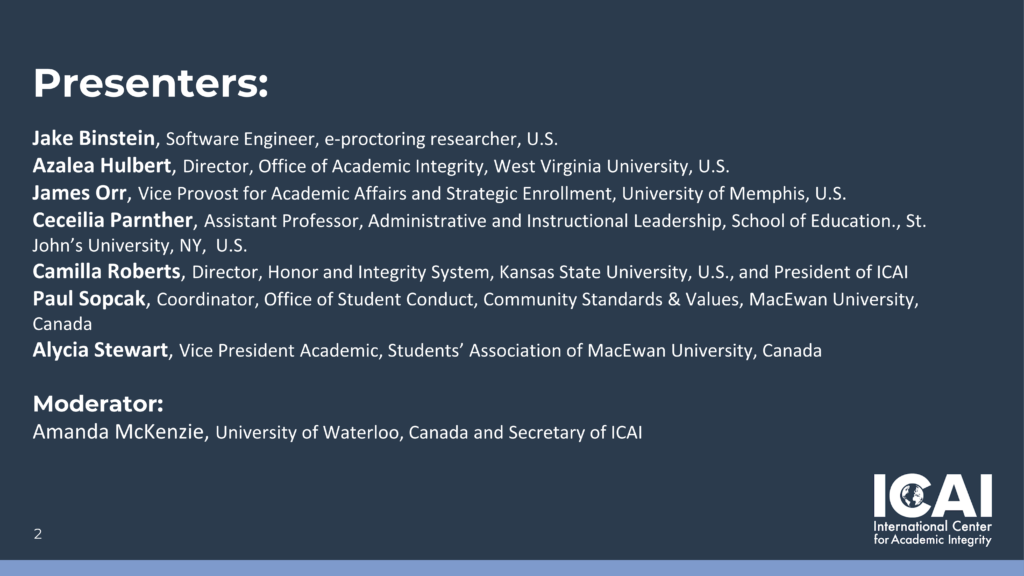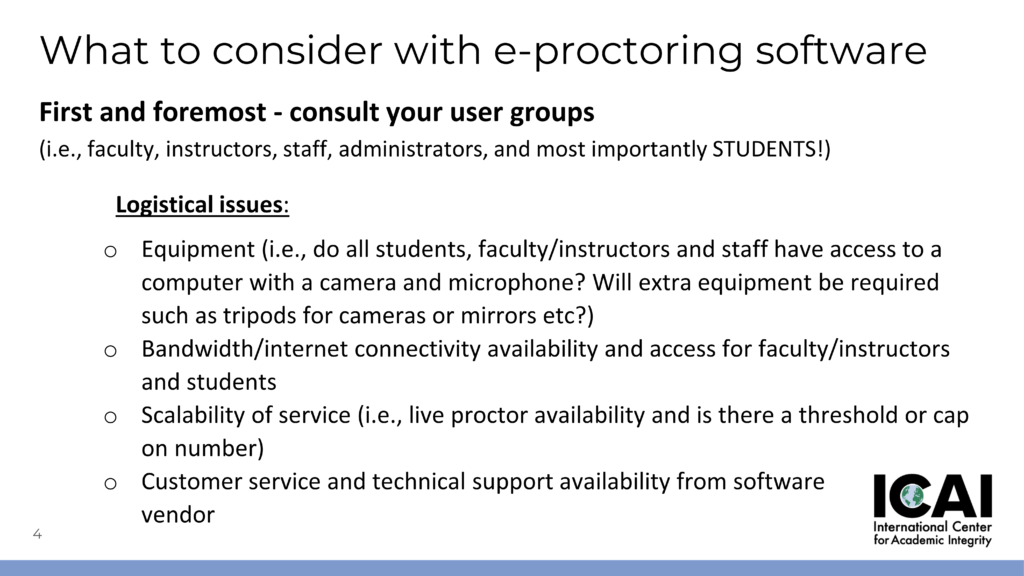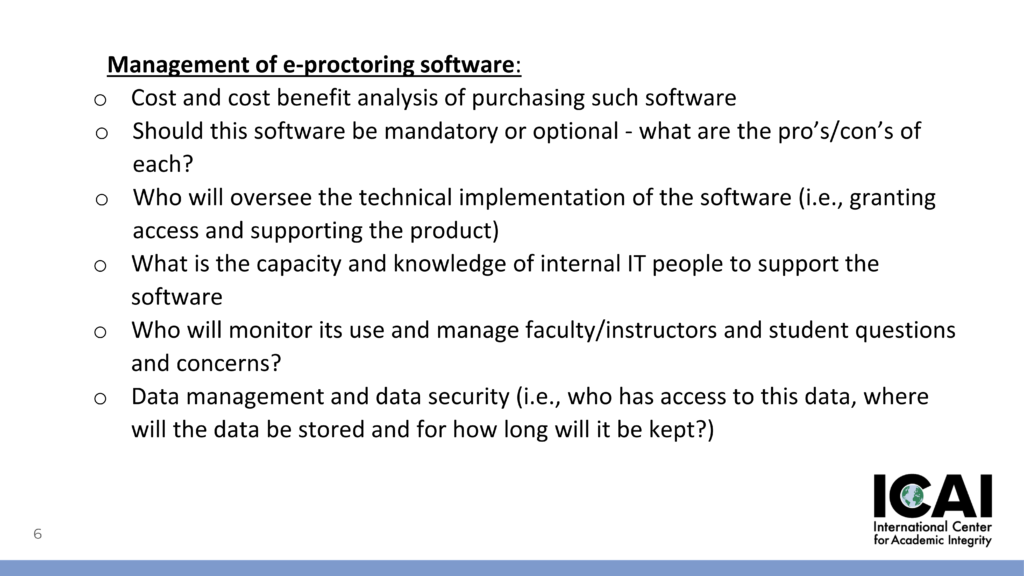BLOG
E-Proctoring Discussion 2.0
On December 11th 2020, I was given the privilege of participating in a second panel from the International Center for Academic Integrity on the subject of e-proctoring. For part 1 of this discussion, please click here.
Transcript below (my speaking portions only):
Table of Contents
What to Consider with E-Proctoring Software
Click here to skip to 2:30
Moderator: At first I’d like to call on Jake Binstein who is going to make a few comments on this slide.
Thank you very much. So with regard to logistical issues, I just want to say, at the top of this slide it says to speak to your students, or your user groups. As someone who just finished a master’s program, I really want to emphasize that. Any book on relationships will tell you that communication is the most important aspect, and a pedagogical relationship is no different.
For me personally, one of the most frustrating things has been the lack of communication with the faculty with regard to software switching or the faculty not necessarily knowing the software. If e-proctoring is new to you, feel free to tell the students that up front. It will really grant you a lot of forgiveness should something go wrong.
I’ll quickly go over a few logistical requirements for the software, and issues that students might have when taking their exams. But I’d just like to point out, as I did last time, that if software is required to take exams, and the exams are required graduate, then these software requirements are actually requirements for higher education, whether the school wants them to be or not. I’d also like to point out that I did go over number of obstacles in our previous webinar, so I’m going to try not to repeat myself too much, but that webinar is available on the ICAI website if you’d like to review.
So, first in regards to equipment, students will need a device with microphone and camera. Some proctoring software actually requires a second device sort of mounted behind you to see in front of you, to get a broader view of of the student’s environment. And some also require a mirror to do the same thing.
But equipment doesn’t just mean computers, it can also mean things like lighting your room. Too much light and it could reflect in your glasses and prevent eye tracking software from working, and too little light and it may prevent facial recognition from working, especially if your student of color and the contrast between your face and the wall behind you is not high enough. We’ve seen a number of reports of students just not being able to take exams because the software won’t let them through. It says there’s no one sitting there. That’s really a big issue they have to solve.
In terms of scalability of services, those proctoring vendors that use live proctors require students to book their exam in advance. If there’s no proctor available during their desired time, the student just can’t take that exam then. Vendors do try to increase their workers during midterms and finals season, but that doesn’t necessarily mean that a student can book a time that’s convenient for them based on their work or their child care schedule.
Regarding technical support, nearly all of the vendors offer some kind of lockdown browser that completely takes over your computer, tracks every movement, kills background processes, all things that would be considered a virus normally. But if your computer rejects that hostile takeover for one reason or another, maybe antivirus software, you just can’t take your exam at all. So it’s really important that students have someone they can talk to in terms of technical support.
Management of E-Proctoring Software
Click here to skip to 11:34
So I just want to point out that we actually found an article published just yesterday in Consumer Reports, I won’t mention the actual brand name of the vendor, but the vendor was hacked this past semester. And a lot of information from Consumer Reports came out – security information, the fact that their code was mismanaged in the number of ways. It’s a very interesting read.
Regarding the last point on this, the the data management and security – as a software engineer, that’s really a big concern of mine. I want to make a few points. The first is that thankfully we see the people are increasingly aware of the use of their data and it’s manipulation.
What we find with e-proctoring is that the software records videos of students, and then those recordings are stored on servers by the e-proctoring vendors, and then teachers can access those videos in order to determine whether or not the student was cheating.
I’m not going to directly accuse any company of anything, I have absolutely no proof, but I want to point out that using the software, we have in computer security parlance, a “vastly increased attack surface.” We have software on the computers of tens of thousands of students that can turn off background processes and turn on webcams, and that’s extremely dangerous.
And you might assume that you can fully trust the e-proctoring vendors. On the one hand, that might actually be true, but there are myriad cases of computer security issues where one company builds a back door into their software and another company, or hackers, exploit it. So we effectively have a back door into every student’s computer at this point.
On the other hand, it is perfectly possible that you really can’t trust these vendors. It’s perfectly possible that in the rush to move classes online, universities didn’t do their due diligence and investigating and performing security audits of these vendors. And furthermore, in an effort to vastly increase their server capacity and service capacity, it’s possible that vendors tripped over themselves and made a few security mistakes along the way.
In conclusion, I want to point out that all of these security issues are not something that universities themselves can handle: these are all things that have to be handled by the vendor. We’re really trusting these vendors a lot to delete the videos when they say they will and to never use their software in any way that doesn’t make sense. And also that the security prevent anyone else from recording or accessing those videos or using their software.
I’m not sure that universities during this this crazy COVID time have really done their due diligence to make sure that every vendor that they use as proper security practices.


